
Setup and test results …
Quickly to the right benchmark results …
Test system
Settings
DDR5-5600 JEDEC
DDR5-6000 XMP/EXPO
DDR5-6400 XMP/EXPO
Summary of test results
DDR5 Testsystem …
We test the 64 GB Crucial DDR5-6400 overclocking memory kit on the following AMD test system.
| CPU | AMD Ryzen 7 9800X3D |
| Mainboard | ASRock B850 Steel Legend WiFi |
| M.2 SSD | Crucial P5 Plus 1TB PCIe Gen 4 |
| Power supply unit | Seasonic Prime TX 1300 ATX3.0 |
Before we start with the benchmarks, we read out the values stored on the modules and found that we received brand new RAM that was only manufactured in week 6 in 2025 at the factory in the USA. As suspected, it is a single-rank assembly with 32Gbit chips from Micron (32Gbit B-Die). As the power supply for DDR5 is on the modules themselves and does not come from the mainboard, it is of course also interesting to know which voltage regulator (PMIC) is installed on the modules. In this case, it is an MPS MP5431GLT chip, which is not designed for high-voltage mode (VDIMM >1.435V). We will clarify later how much power reserve is available for overclocking the DIMMs.
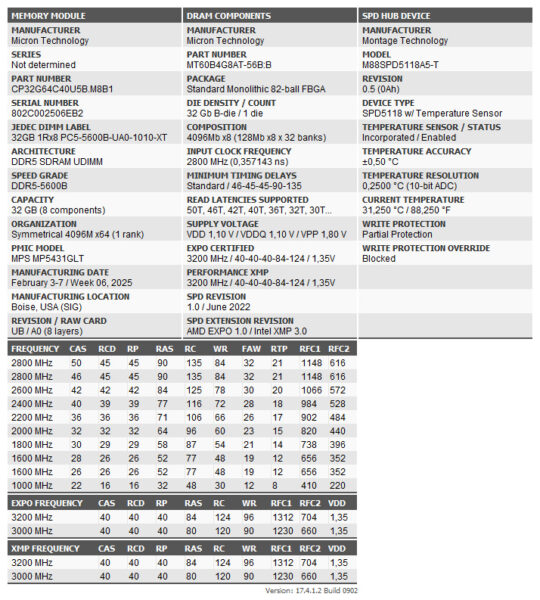
Settings …
In order to keep the following benchmark values as comparable as possible, the AMD Ryzen 7 9800X3D processor was not overclocked and always operated at factory settings. The Infinity Fabric Clock (IFC or FCLK) was also always set to the default value of 2000MHz. We did not change the ratio of UCLK and MCLK manually, but kept it as it was automatically set by the mainboard after selecting the DRAM profile. No latency improvement functions or similar were activated in the BIOS.

Default DDR5-5600 (JEDEC) …
We start with all values set to “Auto”, as is automatically the case after installing the RAM modules.
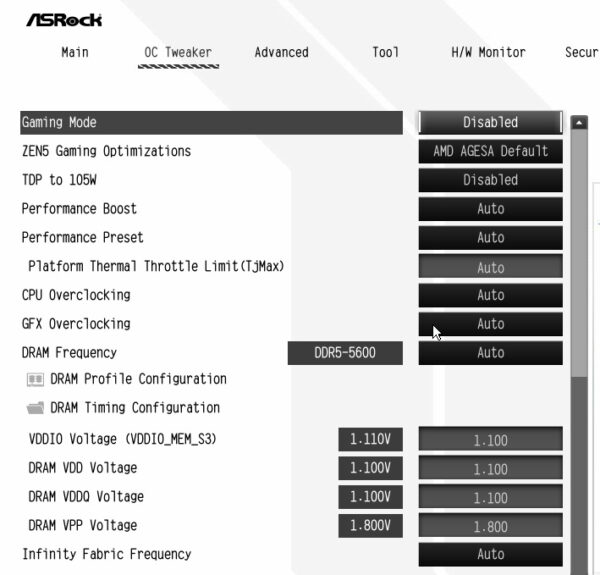
The Aida Cache & Memory Benchmark delivers the following average results with DDR5-5600.
| Frequency | Timing | Memory voltage | Memory read throughput | Memory write throughput | Memory latency |
| 2800 MHz | 46-45-45-90 | 1.1 Volt | 56130 MB/s | 68890 MB/s | 98.5 ns |
In the 3D Mark Time Spy CPU test, we achieved a maximum of 13864 points with the Crucial 64GB kit @DDR5-5600.
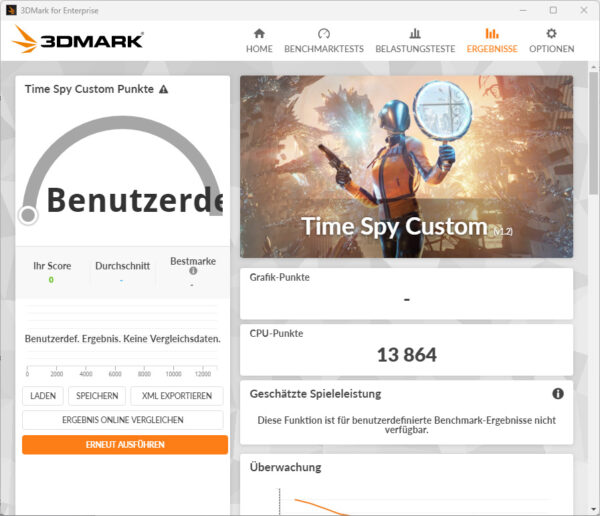
The results are okay for standard values according to the JEDEC specification. The bandwidths are okay, but the latency is quite high at almost 100ns, although the values should not be compared with an AMD Ryzen 7000 processor, for example, as the jump prediction has been changed for the Ryzen 9000 and this can lead to very different results, especially in benchmarks. The power consumption is pleasingly low with a maximum of 3W under load per module, which also results in a low temperature development. We recorded a maximum of 46°C at the end of the 20-minute endurance test with Prime95 Large FFT.
DDR5-6000 XMP/EXPO…
Next, we load the DDR5-6000 EXPO profile in the BIOS.
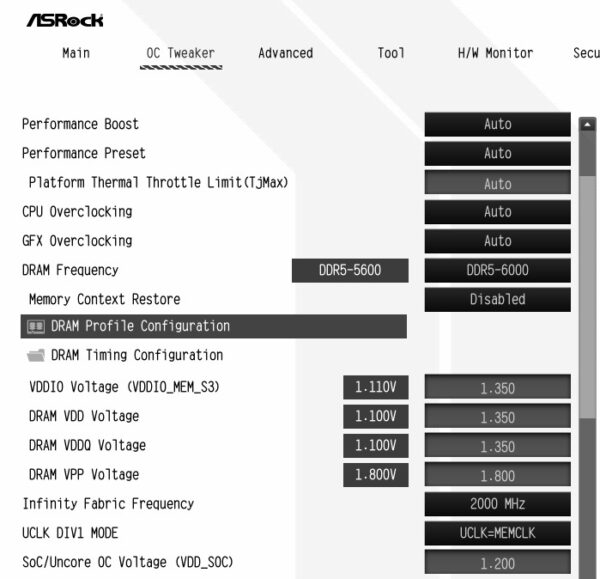
With the DDR5-6000 EXPO settings, the AIDA Cache & Memory Benchmark delivers the following average results.
| Frequency | Timing | Memory voltage | Memory read throughput | Memory write throughput | Memory latency |
| 3000 MHz | 40-40-40-80 | 1.35 Volt | 56900 MB/s | 74350 MB/s | 90 ns |
The read rate only increases by 1.4% with the EPXO 6000 profile, but the write rate increases by almost 8%. We also see a significant improvement in latency, which is almost 9% lower than the initial value.
In the CPU test of 3D Mark Time Spy, the score increases by 5.5% to 14633 points.
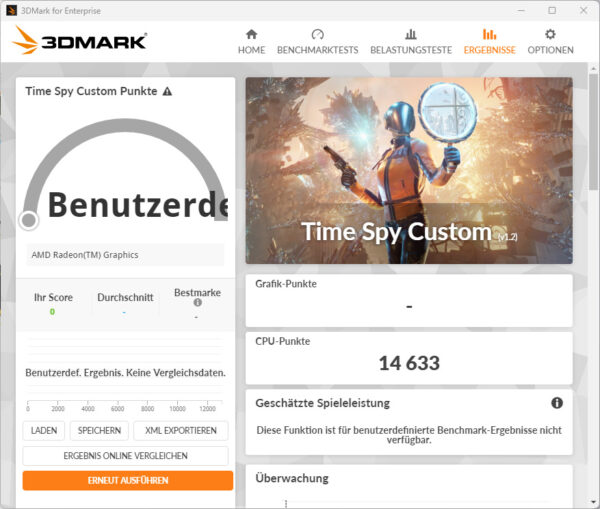
The improvement in the write rate and latency is not only reflected in Time Spy’s CPU benchmark, but also in the power consumption. Each module now consumes up to 6.25W instead of the previous 3W and the temperature at the end of our endurance test was 56.5°C, over 10°C higher than with the efficient JEDEC profile.
DDR5-6400 XMP/EXPO…
Of course, we also activated the EXPO 6400 profile in the next step.
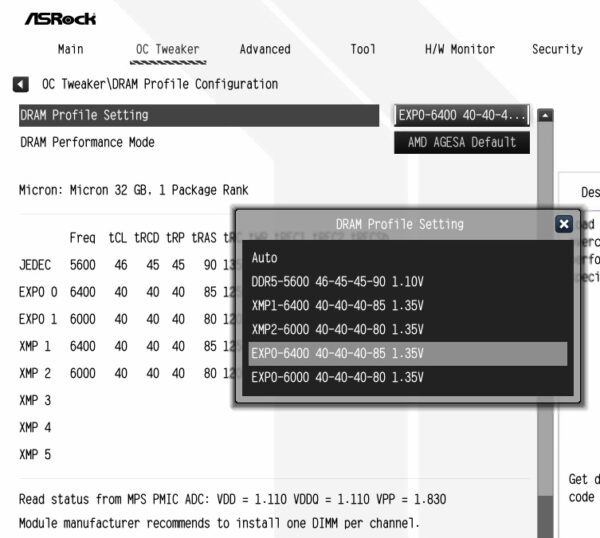
In contrast to the previous tests, the clock frequency of the memory controller was now automatically set to half the UCLK frequency by the mainboard, which means that reduced performance must be expected. The following measured values show whether the higher frequency of the memory can compensate for this shortcoming.

To make sure that the benchmark values were not falsified by problems, we first started the Prime 95 Large FFT test again, as we had done before. Unfortunately, the individual Prime 95 workers sometimes crashed after just a few seconds, but at the latest after a few minutes.
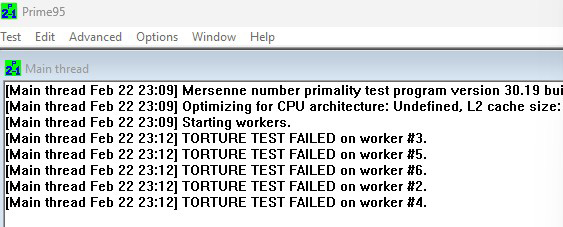
We even experienced blue screens and had to reinstall a benchmark program because it no longer worked after a crash. However, we did not give up so quickly and tried to stabilize the kit with DDR5-6400 with more voltage. But that didn’t work either, because the PMIC didn’t accept voltages higher than 1.39V and prevented the PC from booting. We contacted Crucial to investigate the problem. Unfortunately, the support team could not give us any more tips than to load the BIOS default values and then the EXPO profile. We suspect a faulty kit, as a second memory kit was then able to run the test without any problems. It also turned out later that the first kit with a reduced VDIMM of 1.31V could be operated with the EXPO 6400 profile without any problems. But we only noticed this by chance and EXPO profiles should actually work without any problems in this speed class. It will not have been due to the CPU or the mainboard, as a stable memory speed of 8100MT/s can be achieved on the same mainboard with the same processor if a correspondingly high-performance memory kit is installed.
With the DDR5-6400 EXPO settings, the AIDA Cache & Memory Benchmark delivers the following average results.
| Frequency | Timing | Memory voltage | Memory read throughput | Memory write throughput | Memory latency |
| 3200 MHz | 40-40-40-85 | 1.31 Volt | 57020 MB/s | 78800 MB/s | 89.6 ns |
Although the read rate increases by 0.2% on average with the EPXO 6400 profile compared to the 6000 profile, this is not a significant increase. However, the write rate increases by a further 6%, but the latency stagnates at 89.6ns, almost the same value as with DDR5-6000.
Unsurprisingly, the score in the 3D Mark Time Spy CPU test only increases by around 1% compared to the DDR5-6000 test to 14811 points.
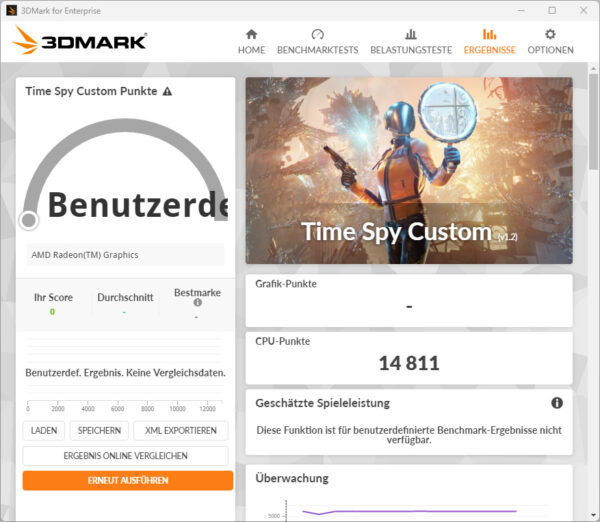
It was to be expected that the highest memory speed would also result in the highest power consumption. Despite a reduced VDIMM of 1.31V instead of 1.35V, the temperature reached a maximum of 59°C at the end of our test, with power consumption of up to 6.35W per module.
Summary of test results …
For a better overview, we have summarized all the test results in a comparison table.
| Setting | Frequency | Timing | Memory voltage | Memory read throughput | Memory write throughput | Memory latency | Time Spy CPU |
| DDR5-5600 CL46 | 2800 MHz | 46-45-45-90 | 1.1 Volt | 56130 MB/s | 68890 MB/s | 98,5 ns | 13846 Pkt. | DDR5-6000 XMP/EXPO | 3000 MHz | 40-40-40-80 | 1.35 Volt | 56900 MB/s | 74350 MB/s | 90 ns | 14633 Pkt. | DDR5-6400 XMP/EXPO | 3200 MHz | 40-40-44-85 | 1.31 Volt | 57020 MB/s | 78800 MB/s | 89,6 ns | 14811 Pkt. |
Even without any manual intervention, the JEDEC 5600 profile already provides quite decent performance. With the XMP or EXPO profiles, the memory performance increases noticeably, but the power consumption and the temperature of the modules also increase. Due to the new manufacturing process, the Crucial Pro Overclocking 2x32GB DDR5-6400 with only 8 memory chips remains relatively economical compared to previous 64GB kits with 16 memory chips. Whether it’s really just bad luck that one of our kits doesn’t run with the EXPO 6400 profile without adjustments, we can’t say for sure. But at least we were able to give a tip on what you can try to get it to work in case someone encounters the same problem.
We would also like to add a small teaser at this point. Since we here at OCinside.de are also tinkerers and don’t give up so easily, we took on the problem kit again later and were able to tease out significantly more performance than the factory overclocking profiles XMP and EXPO were able to achieve. In our DDR5 Tuning Workshop, we will soon reveal how it is possible to elicit almost 20% more performance from this kit and which screws need to be turned to achieve this. It’s worth reading OCinside.de!
Crucial Pro Overclocking 2x32GB DDR5-6400 Result and general impression …


